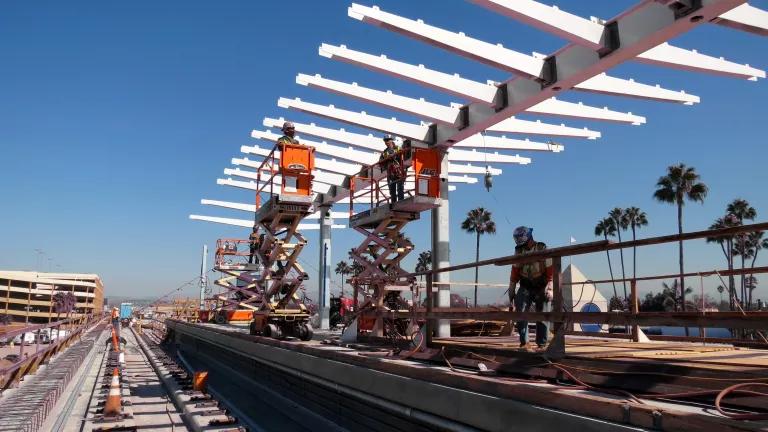
Jessica Russo/NRDC
The California Public Utilities Commission broke new ground this week, approving new rules that will ensure utilities provide “utility-side make-ready” infrastructure (illustrated below) to support electric vehicle (EV) charging at no cost to the typical customer. This will reduce the costs of installing charging stations for cars, trucks, and buses by about 25 percent, fundamentally improving the economics of electrifying the transportation sector.
Previously, utility support for that infrastructure differed significantly for customers participating in utility EV infrastructure programs (where utilities covered the full cost of utility-side make-ready as well as providing support for “customer-side make-ready and often the “charging station” or “EVSE” as well) and customers not participating in such programs (receiving a much lower level of support, dependent on a complicated “line extension allowance” methodology applied on a site-by-site basis).
The new tariffs level the playing field for all customers, regardless of whether they qualify for existing utility programs. And, whereas individual utility EV infrastructure programs with fixed budgets and timeframes are approved in a protracted and uncertain regulatory process, these rules provide long-term, predictable support to customers investing in EVs.
Ultimately, the new tariffs make the provision of that infrastructure simply part of the normal course of utility business. This will take hundreds of thousands of dollars out of the cost of installing charging stations at a typical site and provide a consistent baseline level of support upon which charging companies, state programs, and targeted utility programs can build out the charging network needed to meet air quality, climate, and equity goals.
Assembly Bill 841
The groundbreaking new tariffs come as a result of legislation signed by Governor Newsom last year (Assembly Bill 841, Ting), which directed the utilities to propose new tariffs that allow them to design, install, and maintain electrical infrastructure and all associated work (including literal ground-breaking like trenching, repaving, and protective structures) on the utility side of the meter for all EV customers outside of single-family homes. In past Commission decisions, this has typically been referred to as “utility-side make-ready infrastructure.” Pursuant to that legislation, Pacific Gas & Electric, Southern California Edison, and San Diego Gas & Electric submitted their proposed tariffs in February and will begin implementing them within six months of the Commission’s approval.
The purpose of AB 841, as expressed by the Legislature, was “to change the Commission practice of authorizing the electrical distribution infrastructure located on the utility side of the customer meter needed to charge electric vehicles on a case-by-case basis to a practice of considering that infrastructure and associated design, engineering, and construction work as core utility business.”
Under the new tariffs, participating customers will still bear a significant portion (roughly 70-80 percent) of the total cost of installing EV charging infrastructure at their site in the absence of state or utility incentives, since the tariffs do not cover customer-side distribution infrastructure. As such, customers still have “skin in the game” and an incentive against running up exceedingly high project costs, helping ensure expenditures are generally reasonable. The Commission’s decision also establishes extensive reporting requirements to track the costs and effectiveness of the tariffs over time. Going forward, utility costs will be recovered and reviewed on an ongoing basis in their General Rate Cases, similar to how other distribution infrastructure is treated.
Customers making use of the tariffs will be required to take service on time-varying rates, which will help further reduce the cost of integrating new EV load by encouraging customers to charge during off-peak hours when the grid is underutilized and when renewable energy is abundant. Additionally, the Commission’s decision requires the utilities to propose an average energization timeline to expedite the deployment of EV charging infrastructure, reducing the time between when a customer submits an application and when their site is energized.
Addressing a physical barrier to widespread EV adoption
While EV battery prices are coming down rapidly, there’s no similar cost-reduction curve for trenching, pouring concrete, and running electrical wires. This means that even when EVs have achieved cost-parity with fossil equivalents, the cost of installing charging infrastructure will remain a barrier to widespread adoption. These new tariffs offer a valuable model for how other utilities and states across the country can once and forever remove a huge piece of that barrier--making investment and support for transportation electrification-related infrastructure simply part of the normal course of business and providing the foundational support necessary to help meet their climate, air quality, and equity goals.


